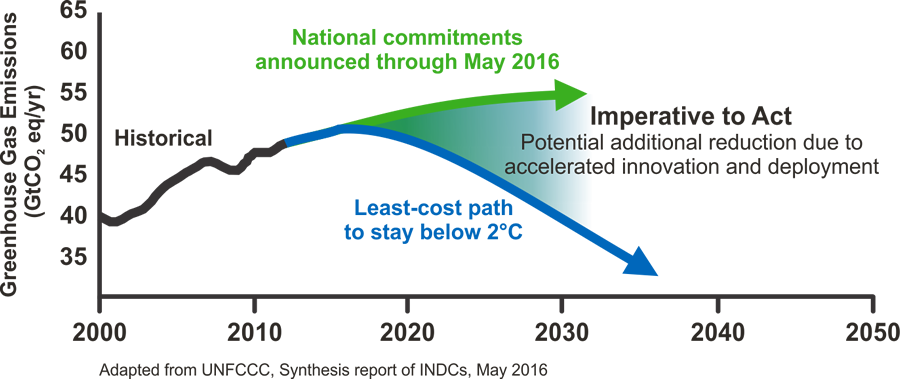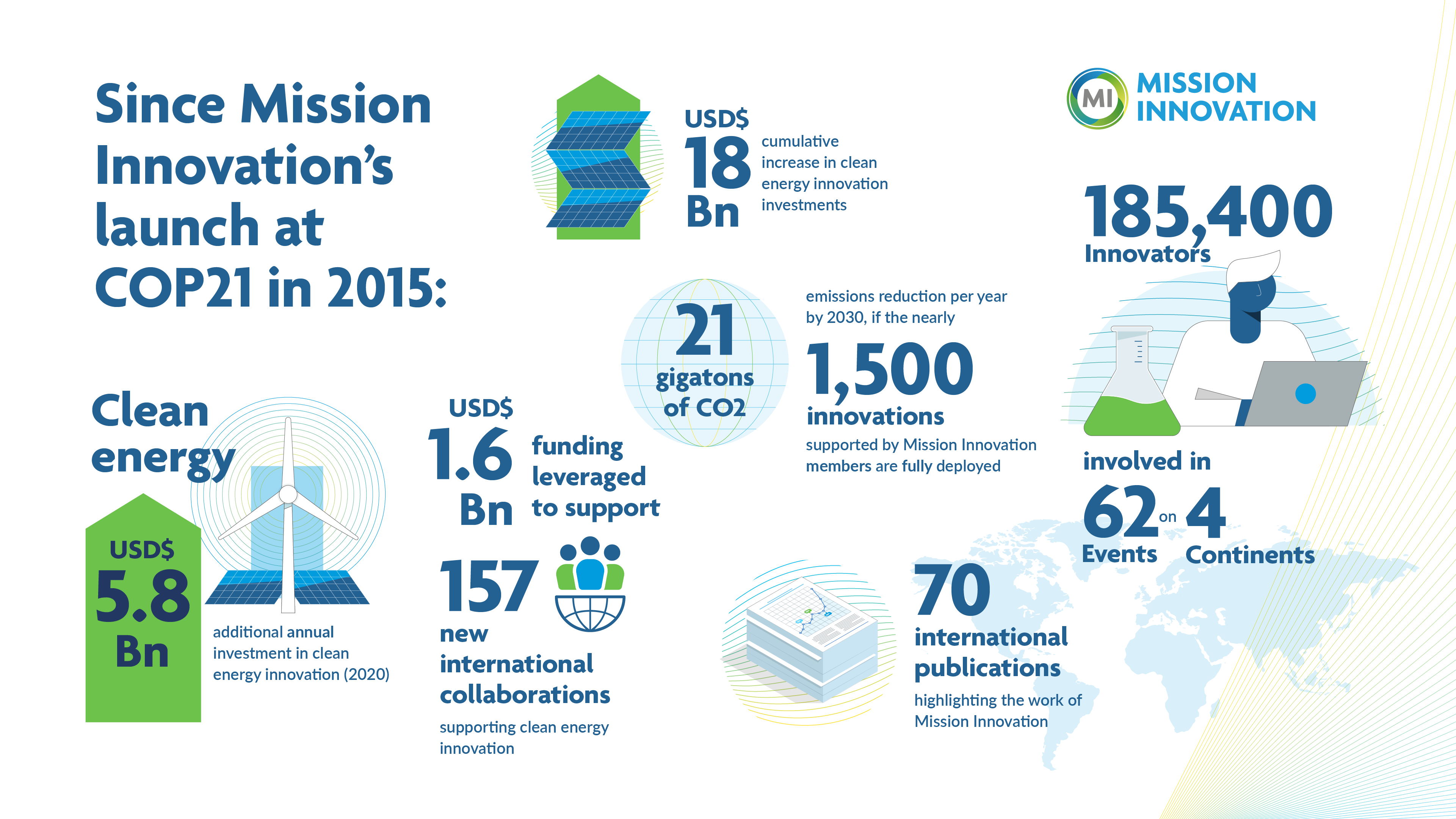Mission Innovation’s first 5 years
Mission Innovation (MI) was announced at COP21 on November 30, 2015, as world leaders came together in Paris to commit to ambitious efforts to combat climate change.

Recap: Mission Innovation’s work
The early goal
Accelerating clean energy innovation is essential to limiting the rise in global temperatures to well below 2˚C. The global community has made remarkable progress in driving down the costs and increasing the use of key clean energy options. However, these impressive gains are still insufficient to meet our long-term climate goals while providing affordable, reliable and secure energy supplies. In support of these efforts, members launched MI in 2015 with the following goal:
In support of economic growth, energy access and security, and an urgent and lasting global response to climate change, our mission is to accelerate the pace of clean energy innovation to achieve performance breakthroughs and cost reductions to provide widely affordable and reliable clean energy solutions that will revolutionize energy systems throughout the world over the next two decades and beyond.
– Enabling Framework for Mission Innovation
As part of the initial launch statement, members committed to:
- Seek to double their governmental and/or state-directed clean energy clean energy research, development and demonstration (RD&D) investments over five years.
- Work closely with the private sector as it increases its investment in the earlier-stage clean energy companies that emerge from government programs.
- Build and improve technology innovation roadmaps and other tools to help in our innovation efforts, to understand where RD&D is already happening, and to identify gaps and opportunities for new kinds of innovation.
- Provide, on an annual basis, transparent, easily-accessible information on their respective clean energy RD&D efforts.

Delivering the goal
MI followed an Action Plan created in 2017 (and an updated Action Plan developed in 2018) that set out four objectives to deliver the overall goal. By the end of 2020, MI helped deliver:
A substantial boost in public sector investment
In the first five years, Mission Innovation saw members increase their investments in clean energy innovation by USD $5.8 bn annually, representing a cumulative increase of USD $18 bn over the 5 years. During this period a number of countries doubled their MI related investments, including Canada, Chile, Japan, Netherlands, Norway and the UK.
- Annual member updates: MI published an annual Country Book highlighting the strategies, activities and public-sector investments (including increments to MI baselines and progress towards the doubling commitment) implemented by members to advance clean energy innovation.
- Strengthened public and private sector RD&D data: MI members worked with collaborating organisations, including the IEA and IRENA, to strengthen the collection of data and to facilitate improved tracking of clean energy public sector and private sector RD&D investment data at a national and global level.
Increased private sector engagement and investment
The private sector plays a vital role in the commercialization and cost-effectiveness of clean energy breakthroughs. Entrepreneurs, investors and businesses drive innovation from the laboratory into the marketplace. Activities that MI and members undertook in its first phase to strengthen private sector engagement included:
- The Global Cooling Prize, an innovation competition to develop a climate-friendly residential cooling solution that can provide access to cooling to people around the world without warming the planet.
- Breakthrough Energy Ventures Europe (BEV-E), a first-of-a-kind €100 million pilot fund that invests in groundbreaking technologies to decarbonize every part of the economy.
- Breakthrough Energy Solutions Canada (BESC), a first-of-a-kind program to support Canadian entrepreneurs and firms to advance clean energy technologies which could significantly reduce global GHG emissions in manufacturing, electricity, transportation, and buildings.
- The 1.5C Compatible Solutions Initiative, a framework to support investors and funders in identifying system solutions and technologies that have significant ability, or potential, to contribute to reduced greenhouse gas emissions in society, so called avoided emissions. In 2020, at the Fifth Mission Innovation Ministerial, we presented 1000 innovations with a total potential to avoid more than 12 gigatons of greenhouse gasses.
- Collaboration with external organisations: MI worked with external organisations, particularly the World Economic Forum and Breakthrough Energy Coalition, to maximise engagement with the private sector to progress impact towards our shared goals.
Increased international collaboration
To help focus members’ resources on the most promising paths, MI fostered collaboration to share lessons learned, reduce duplication of effort, and combine complementary strengths.
- International collaborations: MI encouraged members to form bilateral and multilateral initiatives. New international clean energy RD&D collaborations that MI countries have engaged in since the launch of MI are tracked through Country Book submissions.
- Innovation Challenges: MI members participated in MI’s eight Innovation Challenges to increase collaboration on topics identified as key to advancing the clean energy innovation agenda. Notable achievements include:
- Accelerating CCUS Technologies: IC3 Carbon Capture identified research gaps, opportunities, and priorities in high TRL CCUS technologies.
- Solar Roadmap and Artificial Photosynthesis Prize: In December 2017, the European Commission launched its Prize for Artificial Photosynthesis at the One Planet Summit in Paris
- Advancing Materials Acceleration Platforms (MAPs): IC6 Clean Energy Material’s flagship project has been the advancement of MAPs. By using AI, MAPs allow scientists to produce new materials based on desired properties on a shortened timescale. In May 2021, Canada and Germany announced a new German-Canadian Materials Acceleration Centre, a joint hub for advanced energy materials development.
- Comfort Cooling Box IC7, in collaboration with two IEA TCPs conceptualized the Comfort and Climate Box, an innovative concept to improve energy efficiency in buildings, the CCB integrates heating, cooling, and energy storage solutions into a compact and multifunctional device, compatible with a smart energy grid.
- India’s Clean Energy International Incubator Centre, a first of its kind initiative for promoting innovations in the energy space.
- Joint Call 2019 on Energy Storage Solutions and Joint Call 2020 on Digital Transformation for Green Energy Transition, joint calls between MI members to support transnational research and innovation activities unleashing the potential of digital transformation for a sustainable energy society.
- Read all about the Innovation Challenges’ successes in the MI Innovation Challenges Impact Report
Raised awareness
MI launched several MI initiatives aimed at building the excitement and momentum needed to accelerate the clean energy innovation.
- Keeping clean energy innovation on the global agenda:MI highlighted the importance of clean energy innovation and the work of MI through proactive participation at key events, online and through social media and targeted press opportunities.
- Supporting ideas and innovators: MI members celebrated clean energy RD&D achievementsand the innovators, like the 40 Mission Innovation Champions and the youth who are leading the way towards a sustainable future.
- Assessing progress in key clean energy technology areas:MI analysed indicators currently used by international organisations to track the technical and economic progress of clean energy technologies and supported its members and the clean energy innovation community as they responded to the challenges brought about by COVID-19. Working in collaboration with members and our collaborating organisations, we helped assess impacts, tracked emerging policy responses, and considered the role of innovation in responding to the COVID-19 challenges.
Organization
High-level leadership was provided by MI members’ Ministers with responsibility for clean energy innovation. The MI Steering Committee, comprised of member representatives, provided strategic guidance to foster implementation of MI’s initial Enabling Framework. Core administrative functions are carried out by the MI Secretariat.
Three MI Sub-Groups carried out specific tasks:
- Analysis and Joint Research: Mobilized the collective knowledge, capabilities and resources of members to maximize impact across eight technology areas, known as Innovation Challenges.
- Business and Investor Engagement: Assisted MI members in identifying opportunities and engaging the private sector.
- Ministerial Planning Team: Provided strategic and diplomatic oversight for the annual MI Ministerial.
